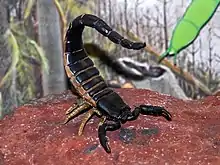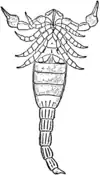| Palaeophonus | |
|---|---|
 | |
| Fossil illustration of Palaeophonus nuncius | |
 | |
| Restoration model | |
| Scientific classification | |
| Domain: | Eukaryota |
| Kingdom: | Animalia |
| Phylum: | Arthropoda |
| Subphylum: | Chelicerata |
| Class: | Arachnida |
| Order: | Scorpiones |
| Suborder: | †Lobosternina |
| Superfamily: | †Palaeophonoidea Thorell & Lindström, 1884 |
| Family: | †Palaeophonidae Thorell & Lindström, 1884 |
| Genus: | †Palaeophonus Thorell & Lindström, 1884 |
| Type species | |
| †Palaeophonus nuncius | |
Palaeophonus (meaning "ancient killer") is one of the oldest known genera of scorpions.[2]
Fossil records
This genus has been reported in the fossil record from the Silurian to the Carboniferous (age range: 428.2 to 314.6 million years ago). Fossils were described from Europe, the United States, and Canada.[3] However revision by Dunlop & Garwood (2023) demonstrated that Allopalaeophonus is a junior synonym of Palaeophonus and that there are only two valid species, P. nuncius Thorell and Lindström 1884 from Sweden and P. caledonicus Hunter, 1886 from Scotland. The species P. arctus Matthew, 1894 from the Carboniferous of Canada and P. lightbodyi Kjellesvig-Waering 1954 from the Silurian of England are nomina dubia.
Description
Palaeophonus resembles modern scorpions, but differs in having short, pointed legs, as opposed to longer legs ending in a pair of claws. It grew to a lengths of 2.5–3.5 in (64–89 mm).[4] These animals did not have eyes and therefore they were blind.[5]
Species
Species within this genus include:[3]
- †P. caledonicus Hunter, 1886
- †P. nuncius Thorell & Lindström, 1884
References
- ↑ Laurie, M. (2012). "XIX.—On a Silurian Scorpion and some additional Eurypterid Remains from the Pentland Hills". Transactions of the Royal Society of Edinburgh. 39 (3): 575–590. doi:10.1017/S0080456800035109. S2CID 163565981.
- 1 2 Dunlop, J. A. (2010). "Geological history and phylogeny of Chelicerata". Arthropod Structure & Development. 39 (2–3): 124–142. doi:10.1016/j.asd.2010.01.003. PMID 20093195.
- 1 2 Paleobiology Database
- ↑ G. A. Polis The Biology of scorpions
- ↑ The Eurypterida of New York Volume 1.pdf/408
- ↑ Gess, R. W. (2013). "The Earliest Record of Terrestrial Animals in Gondwana: a Scorpion from the Famennian (Late Devonian) Witpoort Formation of South Africa". African Invertebrates. 54 (2): 373–379. doi:10.5733/afin.054.0206.
- ↑ Alexander Petrunkevitch, 1953, Paleozoic and Mesozoic Arachnida of Europe
- Steve Parker (2003). Dinosaurus: the Complete Guide to Dinosaurs. Firefly Books. p. 75. ISBN 978-1-55297-772-9.
- Frank H.T. Rodes, Herbert S. Zim en Paul R. Shaffer (1993) - Natuurgids Fossielen (het ontstaan, prepareren en rangschikken van fossielen), Zuidnederlandse Uitgeverij N.V., Aartselaar. ISBN D-1993-0001-361
- s:The Scottish Silurian Scorpion R. I. Pocock, 1901
- Dunlop, J. A. & Garwood, R. J. 2023. The status of two fossils assigned to the scorpion genus Palaeophonus and its interpretation as a senior synonym of Allopalaeophonus. Arachnology, 19: 940-943.

